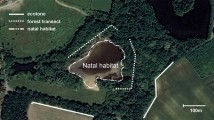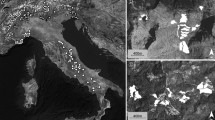Abstract
Sexual and asexual organisms often vary in their distribution and abundances among habitats. These patterns of “geographical parthenogenesis” can shed light on ecological conditions underlying the evolution of sex. Habitat disturbance is hypothesized to be a mechanism that generates geographical parthenogenesis. Parthenogens are predicted to be more prevalent in disturbed habitats than sexuals due to the greater colonizing ability of parthenogens and the tendency of parthenogens to avoid competition with sexuals in undisturbed habitat. We tested whether habitat disturbance (i.e., a rapid state transition between vegetation communities) causes geographical parthenogenesis in whiptail lizards in the Chihuahuan Desert of southern New Mexico. Non-experimental approaches have shown the parthenogenetic Aspidoscelis uniparens commonly occurs in habitat with a history of vegetation disturbance from shrub removal, whereas the sexual A. marmorata occurs more often in undisturbed shrubland habitat. We used a field experiment replicated across 16 sites to test whether the parthenogen A. uniparens and sexual A. marmorata differ in their response to vegetation disturbance from shrub removal. The sites were distributed across a broad region of southern New Mexico, and we used a paired design with each site including a shrub-removal treatment and a control on 9-ha plots. Using a co-abundance model that accounts for imperfect detection, we found the parthenogen A. uniparens and sexual A. marmorata both responded positively to disturbance, but only when the congener was rare. Our results are inconsistent with the idea that parthenogens exploit disturbed habitat to avoid competition with sexuals. In our study system, A. uniparens often dominates older disturbed sites, especially two decades or more after shrub removal. Collectively, these results indicate geographical parthenogenesis emerges from biotic interactions in heterogeneous landscapes that include disturbed habitats used by sexual and asexual species alike.



Similar content being viewed by others
Data availability
The data and code for our models are available at https://github.com/bcosentino/whiptail-coabundance.
References
Bell G (1982) The masterpiece of nature: the evolution and genetics of sexuality. University of California Press, Berkeley
Bestelmeyer BT, Peters DPC, Archer SR, Browning DM, Okin GS, Schooley RL, Webb NP (2018) The grassland-shrubland regime shift in the southwestern United States: misconceptions and their implications for management. Bioscience 68:678–690
Brodie J, Helmy OE, Mohd-Azlan J, Granados A, Bernard H, Giordano AJ, Zipkin E (2018) Models for assessing local-scale co-abundance of animal species while accounting for differential detectability and varied responses to the environment. Biotropica 50:5–15
Case TJ (1990) Patterns of coexistence in sexual and asexual species of Cnemidophorus lizards. Oecologia 83:220–227
Case TJ, Taper ML (1986) On the coexistence and coevolution of asexual and sexual competitors. Evolution 40:366–387
Coffman JM, Bestelmeyer BT, Kelly JF, Wright TF, Schooley RL (2014) Restoration practices have positive effects on breeding bird species of concern in the Chihuahuan Desert. Restor Ecol 22:336–344
Congdon JD, Vitt LJ, Hadley NF (1978) Parental investment: Comparative reproductive energetics in bisexual and unisexual lizards, genus Cnemidophorus. Am Nat 112:509–521
Cosentino BJ, Schooley RL, Bestelmeyer BT, Coffman JM (2013) Response of lizard community structure to desert grassland restoration mediated by a keystone rodent. Biodivers Conserv 22:921–935
Cuellar O (1971) Reproduction and the mechanism of meiotic restitution in the parthenogenetic lizard Cnemidophorus uniparens. J Morphol 133:139–165
Cuellar O (1976) Intraclonal histocompatibility in a parthenogenetic lizard: evidence of genetic homogeneity. Science 193:150–153
Cuellar O (1977) Animal parthenogenesis. Science 197:837–843
Cuellar O (1979) On the ecology and coexistence in parthenogenetic and bisexual lizards of the genus Cnemidophorus. Am Zool 19:773–786
Cuellar O (1981) Long-term analysis of reproductive periodicity in the lizard Cnemidophorus uniparens. Am Midl Nat 105:93–101
Cuellar O (1984) Reproduction in a parthenogenetic lizard: With a discussion of optimal clutch size and a critique of the clutch weight/body weight ratio. Am Midl Nat 111:242–258
Cuellar O (1993) Further observations on competition and natural history of coexisting parthenogenetic and bisexual whiptail lizards. In: Wright JW, Vitt LJ (eds) Biology of whiptail lizards (Genus Cnemidophorus). Oklahoma Museum of Natural History, Norman, pp 345–370
Densmore LD, Moritz CC, Wright JW, Brown WM (1989) Mitochondrial-DNA analyses and the origin and relative age of parthenogenetic lizards (Genus Cnemidophorus) IV Nine sexlineatus-group unisexuals. Evolution 43:969–983
Dixon JR (2009) Marbled whiptail. In: Jones LLC, Lovich RE (eds) Lizards of the American Southwest. Rio Nuevo Publishers, Tucson, pp 362–365
Eldridge DJ, Bowker MA, Maestre FT, Roger E, Reynolds JF, Whitford WG (2011) Impacts of shrub encroachment on ecosystem structure and functioning: towards a global synthesis. Ecol Lett 14:709–722
Fuentes-Ramirez A, Mudrak EL, Caragea PC, Holzapfel C, Moloney KA (2015) Assessing the impact of the spatial distribution of Larrea tridentata in the Sonoran Desert, USA. Oecologia 178:473–484
Gaggiotti OE (1994) An ecological model for the maintenance of sex and geographical parthenogenesis. J Theor Biol 167:201–221
Gelman A, Hill J (2007) Data analysis using regression and multilevel/hierarchical models. Cambridge University Press, Cambridge
Gibson AK, Delph LF, Lively CM (2017) The two-fold cost of sex: experimental evidence from a natural system. Evol Lett 1–1:6–15
Glesener RD, Tilman D (1978) Sexuality and the components of environmental uncertainty: Clues from geographical parthenogenesis in terrestrial animals. Am Nat 112:659–673
Hamilton WD (1980) Sex vs. non-sex vs. parasite. Oikos 35:282–290
Hanley KA, Bolger DT, Case TJ (1994) Comparative ecology of sexual and asexual gecko species (Lepidodactylus) in French Polynesia. Evol Ecol 8:438–454
Herrick JE, Van Zee JW, McCord SE, Courtright EM, Karl JW, Burkett LM (2017) Monitoring manual for grassland, shrubland, and savanna ecosystems. USDA-ARS Jornada Experimental Range, Las Cruces
Jaenike J (1978) A hypothesis to account for the maintenance of sex within populations. Evol Theory 3:191–194
Jennings RD (2009) New Mexico whiptail (unisexual). In: Jones LLC, Lovich RE (eds) Lizards of the American Southwest. Rio Nuevo Publishers, Tucson, pp 366–369
Kearney M, Fujita MK, Ridenour J (2009) Lost sex in the reptiles: constraints and correlations. In: Schön I, Martens K, Dijk P (eds) Lost sex: the evolutionary biology of parthenogenesis. Springer, Dordrecht, pp 447–474
Kéry M, Royle JA (2016) Applied hierarchical modeling in ecology: analysis of distribution, abundance, and species richness in R and BUGS, vol 1. Elsevier, London
Lavanchy G, Strehler M, Llanos Roman MN et al (2016) Habitat heterogeneity favors asexual reproduction in natural populations of grassthrips. Evolution 70:1780–1790
Lively CM, Morran LT (2014) The ecology of sexual reproduction. J Evol Biol 27:1292–1303
Mata-Silva V, Ramírez-Bautista A, Johnson JD (2010) Reproductive characteristics of two syntopic whiptail lizards, Aspidoscelis marmorata and Aspidoscelis tesselata, from the northern Chihuahuan Desert. Southwest Nat 55:125–129
Maynard Smith J (1978) The evolution of sex. Cambridge University Press, Cambridge
Meirmans S, Meirmans PG, Kirkendall LR (2012) The costs of sex: facing real-world complexities. Q Rev Biol 87:19–40
Menke SB (2003) Lizard community structure across a grassland-creosote bush ecotone in the Chihuahuan Desert. Can J Zool 81:1829–1838
Mitchell JC (1979) Ecology of southeastern Arizona whiptail lizards (Cnemidophorus: Teiidae): population densities, resource partitioning, and niche overlap. Can J Zool 57:1487–1499
Neiman M, Meirmans PG, Schwander T, Meirmans S (2018) Sex in the wild: how and why field-based studies contribute to solving the problem of sex. Evolution 72:1194–1203
Orrock JL, Fletcher RJ (2005) Changes in community size affect the outcome of competition. Am Nat 166:107–111
Painter CW, Stuart JN, Tomasz Giermakowski J, Pierce LJS (2017) Checklist of the amphibians and reptiles of New Mexico, USA, with notes on taxonomy, status, and distribution. West Wildl 4:29–60
Paulissen MA, Walker JM, Cordes JE (1992) Can parthenogenetic Cnemidophorus laredoensis (Teiidae) coexist with its bisexual congeners? J Herpetol 26:153–158
Perkins SR, McDaniel KC, Ulery AL (2006) Vegetation and soil change following creosotebush (Larrea tridentata) control in the Chihuahuan Desert. J Arid Environ 64:152–173
Pianka ER (1966) Deserts, lizards, and spatial heterogeneity. Ecology 47:1055–1059
Pianka ER (1967) On lizard species diversity: North American flatland deserts. Ecology 48:333–351
Plummer M (2017) JAGS version 4.3.0 user manual. https://sourceforge.net/projects/mcmc-jags/files/Manuals/4.x/. Accessed Oct 2018
Price AH, Lapointe JL, Atmar JW (1993) The ecology and evolutionary implications of competition and parthenogenesis in Cnemidophorus. In: Wright JW, Vitt LJ (eds) Biology of whiptail lizards (Genus Cnemidophorus). Oklahoma Museum of Natural History, Norman, pp 371–410
R Core Team (2018) R: a language and environment for statistical computing. R Foundation for Statistical Computing, Vienna, Austria. https://www.R-project.org
Reeder TW, Cole CJ, Dessauer HC (2002) Phylogenetic relationships of whiptail lizards of the genus Cnemidophorus (Squamata: Teiidae): a test of monophyly, reevaluation of karyotypic evolution, and review of hybrid origins. Am Mus Novit 3365:1–61
Revelle W (2018) Psych: procedures for personality and psychological research. Northwestern University, Evanston, Illinois, USA. https://CRAN.R-project.org/package=psych. Accessed Oct 2018
Royle JA (2004) N-mixture models for estimating population size from spatially replicated counts. Biometrics 60:108–115
Schall JJ (1978) Reproductive strategies in sympatric whiptail lizards (Cnemidophorus): two parthenogenetic and three bisexual species. Copeia 1978:108–116
Schlesinger WH, Reynolds JF, Cunningham GL, Huenneke LF, Jarrell WM, Virginia RA, Whitford WG (1990) Biological feedbacks in global desertification. Science 247:1043–1048
Schooley RL, Bestelmeyer BT, Campanella A (2018) Shrub encroachment, productivity pulses, and core-transient dynamics of Chihuahuan Desert rodents. Ecosphere 9(7):e02330
Su Y-S, Yajima M (2015) R2jags: using R to run “JAGS”. R package version 0.5-7. https://CRAN.R-project.org/package=R2jags. Accessed Oct 2018
Tilquin A, Kokko H (2016) What does the geography of parthenogenesis teach us about sex? Philos Trans R Soc Lond. Ser B 371:20150538
Vandel A (1928) La parthénogenèse géographique. Contribution à l’étude biologique et cytologique de la parthénogenèse naturelle. Bulletin Biologique de la France et de la Belgique 62:164–281
Vrijenhoek RC, Parker ED Jr (2009) Geographical parthenogenesis: general purpose genotypes and frozen niche variation. In: Schön I, Martens K, Dijk P (eds) Lost sex: the evolutionary biology of parthenogenesis. Springer, Dordrecht, pp 99–131
Wright JW (1993) Evolution of the lizards of the genus Cnemidophorus. In: Wright JW, Vitt LJ (eds) Biology of whiptail lizards (Genus Cnemidophorus). Oklahoma Museum of Natural History, Norman, pp 27–82
Wright JW, Lowe CH (1968) Weeds, polyploids, parthenogenesis, and the geographical and ecological distribution of all-female species of Cnemidophorus. Copeia 1968:128–138
Acknowledgements
This work is supported by Agroecosystem Management Program Grant No. 2016-67019-25212 from the USDA National Institute of Food and Agriculture. Shrub removal treatments were applied by the United States Bureau of Land Management—Las Cruces. Because the work involved only remote observation of lizards through binoculars, without disturbance, no ethics permits were required under local laws. We thank S. Callahan and Q. Johnson for field assistance and B. Fischman and A. Tilquin for comments on the manuscript. The authors declare no conflicts of interest.
Author information
Authors and Affiliations
Contributions
BJC, RLS, and BTB designed the study. HC and LMB collected the data. BJC analyzed the data and wrote the manuscript. All authors edited the manuscript.
Corresponding author
Additional information
Publisher's Note
Springer Nature remains neutral with regard to jurisdictional claims in published maps and institutional affiliations.
Electronic supplementary material
Below is the link to the electronic supplementary material.
Rights and permissions
About this article
Cite this article
Cosentino, B.J., Schooley, R.L., Bestelmeyer, B.T. et al. Does habitat disturbance promote geographical parthenogenesis in whiptail lizards?. Evol Ecol 33, 839–853 (2019). https://doi.org/10.1007/s10682-019-10006-3
Received:
Revised:
Accepted:
Published:
Issue Date:
DOI: https://doi.org/10.1007/s10682-019-10006-3




